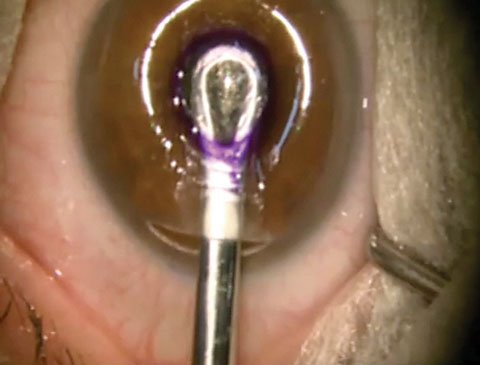Presbyopes are always looking for options to eliminate the need for reading glasses. Historically, there were very limited surgical options for the presbyope with a clear lens until the advent of the Kamra corneal inlay (AcuFocus).
The device uses pinhole optics to increase a patient’s depth of focus, improving vision at intermediate and near while still maintaining distance vision. It is a donut shaped disc 3.8mm in diameter with a 1.6mm aperture and a thickness of roughly 5µm. It has 8400 micro perforations for corneal nutrient flow and is made of PVDF. Placement is approximately 250µm deep in the corneal stroma of the patient’s nondominant eye using a femtosecond-created pocket and is centered on the visual axis.1
The Right Patient Population
The ideal candidate is emmetropic in the dominant eye and mildly myopic in the nondominant. Around -0.50D to -0.75D is ideal, according to FDA data.1 Patients may be naturally emmetropic, post-refractive, pseudophakic with a monofocal implant or have refractive surgery to achieve the ideal target.
A Kamra patient needs to have a clear lens, healthy cornea and a good tear film. Patients who are not good candidates for any other type of refractive surgery are likely not good candidates for this procedure. As with any type of refractive surgery, stabilizing the tear film prior to surgery is crucial, as it affects visual outcome and patient satisfaction.
 |
| The surgeon places the Kamra corneal inlay and then waits for it to settle and adhere to the corneal stroma. |
Surgical Process
Prior to surgery, the patient will be measured on the Acutarget HD (AcuFocus) to check for optical scatter (lens dysfunction), provide a dynamic tear film assessment and determine proper placement.
Using a surgical microscope, the surgeon will mark the Purkinje, create the pocket using a femtosecond laser and insert the inlay centering around the marking.
Postop
After the procedure, patients are placed on an antibiotic, a three-month minimum course of steroids and regular use of artificial tears. At three months if the patient is healing well and vision is good, the drops may be discontinued. If any issues persist, drops may be continued for an extended period of time. Every surgeon has a different drop regime, so comanaging optometrists should check with the surgery center on its protocol. We have found putting patients on a cyclosporine drop preoperatively and postoperatively helps speed up visual recovery.
Patients should expect a slow visual recovery, with the majority of patients comfortably reading and seeing well at distance by one month. Roughly 20% of our patients notice immediate near vision improvement, while the remaining 80% take a few weeks to a few months to read comfortably.
Advantages
With the Kamra inlay, the patient is fully binocular at distance. Even though the average patient is mildly myopic, the pinhole effect improves vision, giving them distance vision, as well as near. This eliminates the imbalance monovision patients often complain about. Additionally, as the inlay is based on small-aperture optics, the reading will maintain as presbyopia progresses.
The Kamra inlay is an excellent option for well-selected presbyopic patients who are not ready for a lens-based procedure. I’ve had it for more than three years and have yet to use reading glasses.
Dr. Black is vice president and clinical director at Crystal Clear Vision in Toronto, where she examines and counsels patients seeking refractive surgery, including laser, corneal and lenticular procedures.
| 1. Kamra Inlay. AcuFocus. Available at www.acufocus.com/us/products/kamra-inlay. Accessed September 16, 2016. |

